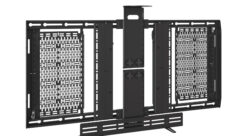There when you need itIn a poorly designed fall-protection system, everything looks fine – until a worker’s life depends on it.
Dec 20, 1996 12:00 PM,
Rocky PaulsonPaulson is president of Stage Rigging in San Carlos, CA.
Fall protection seems to be one of today’s entertainment industry hot buttons. Articles are being written on the subject, heated debates have popped up on the Internet, and many companies and buildings have rushed to install systems in the past few years. “What is it, and why do we need it now?” seem to be the first two questions that come up in these discussions.
As contractors, we need fall protection because workers in our industry fall and are killed or seriously injured.
In 1970 the U.S. government passed a series of federal laws referred to as OSHA. These laws are in the Code of Federal Regulations (CFR), Title 29, Parts 1900 through 1999. Part 1910 is referred to as the General Industry Safety Orders, and Part 1926 is the Construction Industry Orders. These laws require that every employer protect every employee from injury during the normal course of work. The specific law regarding this is 1910.132.
Fall into the basicsIn the general sense, fall protection is any system that drastically reduces or eliminates injury from employee falls. An air bag is fall protection for a stunt man. Probably the most common method of fall protection is a guardrail system as installed on almost all catwalks and stairways. Guardrails are so passive in their function as a fall protection system that we generally give them little or no thought as they perform their function.
When we must work outside the confines of a guardrail system, a personal fall-arrest system (PFAS) is generally used to maintain 100% protection. The PFAS in its simplest form consists of a full-body harness with a dorsal attachment ring connected to an anchorage on the structure. The harness and the anchorage are always components of the PFAS, and the main variation in systems is the method used to connect the two.
The work task is what determines the connecting means. If little or no mobility is required, a simple lanyard may sufficiently connect the harness to the anchorage. If vertical motion is required, a vertical lifeline and fall arrester or retractable lifeline are included in the system. If horizontal motion is called for, a horizontal lifeline or track system is used between the harness and anchorage. Because of all these variables, the PFAS is a much more active method of fall protection than guardrails. Because of the system’s active use, the user must evaluate each component to ensure that it will perform properly when combined with the rest of the system.
One of the easiest methods to establish confidence in a system is to look for permanent labels on the components that say ANSI A10.14-1991 or ANSI Z359.1-1992. Both of these standards specify construction and testing of fall-protection equipment. The labels indicate that the components comply with the referenced standards; if they comply with the standard, they will also comply with most laws.
But the labeling will not tell the user whether the system will function properly. Components that are safe individually can be combined in a fashion that creates an unsafe system. Using components without appropriate labeling is risky because subsystems, such as harnesses, are manufactured for purposes other than fall protection, and most of these applications have less demanding design requirements.
What can we do?As with anything new in this creative industry of ours, many of us try different approaches. This in and of itself is not a bad thing. The problem that arises is that not all systems and methods are effective. If we accept the premise that we are installing and using fall protection to minimize injury to our employees, then we must be sure the systems we use actually work.
Riggers must use the equipment and install the equipment for others to use. Because many of the principles are the same, riggers are the best qualified individuals on the job to make fall-protection decisions. But system installation rigging is quite different from general rigging. By looking at the differences, we can more easily see why good systems are designed the way they are.
Only when neededWith regular rigging systems, the load is permanently placed and balanced. If a bad decision is made, it will become apparent as the system is loaded; the chain may break or the steel will deflect. As long as proper procedures are followed, no one will get hurt.
This is not the case with fall-protection systems. If the system fails when the load is applied, severe injury or death is the automatic and inevitable result. This difference must be kept continually in the forefront of our awareness when evaluating a system design. Connections must be evaluated for strength and compatibility. If the physical size of a hook-and-eye bolt connection is not considered, hook roll-out can occur. Everything will look fine until a worker’s life depends on the bad connection. Just when the worker falls and the hook-and-eye bolt connections begin to take a load, the hook may roll out of the eye bolt, resulting in tragedy. To prevent this, the eye bolt or Dee ring must be large enough so the edge cannot rest on the latch of the hook or carabiner in a slack condition. To make the system more passive, so the user doesn’t have to think about this dangerous condition, the fall protection industry is now exclusively using auto-locking carabiners and self-locking latch hooks.
Wire rope clips are also dangerous when associated with fall protection. Fall protection failures have occurred because the wire rope has pulled out of the clips. One of the big problems with using wire rope clips is that they must be tightened after the load is applied. This requires suspending a load equal to the maximum expected impact load from the lifeline during installation. It is unfortunately not done in most installations where wire rope clips are used. California has its own OSHA requiring that wire-rope terminations in fall protection have an 85% efficiency. The Wire Rope User’s Manual rates the efficiency of wire rope clip terminations at 80%. It doesn’t take too great a leap of imagination to realize Cal OSHA picked 85% to preclude the use of wire rope clips. The designers and installers of good systems must do more research, more calculation and more testing than that done by designers and installers of other rigging systems to avoid the problems associated with the sudden and occasional loading of PFASs.
Higher impact loadsUnlike regular rigging systems, a fall protection system is subjected to a large impact load or maximum arrest force (MAF). For the most part, the largest dynamic or impact loads occur in our normal daily rigging when we are lifting or lowering loads using chain hoists. These forces range from 125% to an extreme of 350% of the static load. If we lift 1,000 pounds (450 kg), we put forces of between 1,250 pounds (5.56 kN) and 3,500 pounds (15.56 kN) into the rigging system each time we start or stop the hoists.
Though these numbers may seem high, the dynamic forces in a PFAS can be much greater. The term used to describe the impact force caused by stopping a falling worker is arrest force. To get a feeling for the magnitude of this force, several factors must be considered.
The first thing to look at is the weight on the system without any dynamic forces added. Most PFAS are designed to arrest a fall of a worker weighing no more than 310 pounds (139.5 kg).
The second factor affecting the arrest force is the rate of deceleration or deceleration distance (DD). (See Figure 1.) A shorter DD results in a higher arrest force. When a fall is arrested in a harness, the torso may decelerate very rapidly but the arms, legs and head will continue to move. This makes the arrest force less than that associated with rigid weights of the same magnitude. As a back up to the engineering calculations of these forces, it has become an accepted practice to do dynamic testing of PFASs with a 220 pound (99 kg) rigid weight because it approximates the results of using a 310 pound person as a test dummy.
The third factor affecting impact force is the speed at which the load is traveling before decelerating. In fall protection, this can be quantified using the freefall distance (FFD). (See Figure 1.) As the FFD increases, so does the impact force. In a properly designed PFAS, the FFD should never be more than 6 feet (1.8 m).
These three variables combined in various forms can result in a wide range of arrest forces. When doing drop tests having an FFD of 2 feet (0.6 m), we have seen arrest forces as low as 600 pounds (2.7 kN) when using energy absorbing lanyards and more than 5,000 pounds (22 kN) using 1/4 inch (6 mm) aircraft cable as the lanyard.
A well-designed system results in an impact force of around 200% on the low end and well over 1,500% for a poorly designed system. These percentages are well above those indicated from normal lifting and lowering situations. It is logical to assume that a low arrest force is good and a high one is bad, but how high is too high?
Medical studies done in Europe indicate that 12 kN (2,700 pounds) was the point at which injury resulted from arrest force using full-body harnesses. When lawmakers in the United States had to decide on a maximum arrest force (MAF), they took two-thirds of this number and made 1,800 pounds (8 kN) the maximum allowable. All harnesses made for fall protection in the United States are designed to withstand a MAF of 1,800 pounds.
The most important thing to remember about arrest force is that, although the law allows for a 6 foot (1.8 m) FFD, one must use an energy-absorbing lanyard. To my knowledge, no straight lanyard, whether it be wire rope, synthetic rope or web, will keep the arrest force under 1,800 pounds when stopping a fall with an FFD of 6 feet.
In well-designed systems, the MAF is kept far under 1,800 pounds by ensuring the FFD is well under 6 feet through the use of self-retracting lanyards or retractable lifelines. When this approach is not possible, in-line energy absorbers (EA) are installed on the anchorage or lanyard to lower the MAF. At the very minimum, the system must be designed to produce an MAF of 1,800 pounds or less to be legal.
Anchorage strengthIn the discussion of arrest force and MAF, we have assumed that the lanyard connects the full-body harness directly to an anchorage. An anchorage is a secure attachment point for the purpose of attaching a PFAS. How strong must this attachment point be?
Rigging components usually have a design factor or safety factor between 4:1 and 7:1. Although this does not include a provision for impact load, it still gives the rigger a large margin for error or ignorance, except in cases where extreme impact for-ces are not accounted for. This is good in many ways. At some point all riggers have been misled about the weight of whatever they are hanging or have forgotten to add in the weight of the loudspeakers added to a lighting truss or any number of other last minute changes to a plan. Though a rigger should not encroach into the design margin, it has happened either knowingly or unwittingly to all of us.
One problem with this large margin for error is that it allows riggers who may not know all they should to appear competent. A rigger can make a rather large error without catastrophic result. On the other hand, fall-protection systems are built with a design factor of 2:1. Although this is based on MAF, not the static load, much less room for error exists in both the system design and worker misuse.
According to the federal OSHA, the answer to the anchorage strength question is that it must be able to withstand a force of 5,000 pounds (22 kN) of ultimate strength per attached worker or be designed as part of a complete system using a design factor of 2:1 and built by a qualified person. Few, if any, practicing riggers fit the strict definition of a qualified person. Even using the conservative 5,000 pound number, an FFD of less than 6 feet could easily cause an anchorage failure through misuse or poor design.
In an ideal world, a rigger would select a PFAS anchorage in the same manner as selecting an anchorage for general rigging, which would be to review the load chart provided by the building structural engineer, who is a qualified person, and select an anchorage designated for that purpose. If PFAS anchorages are not noted, the PFAS should be considered a static load of 2,000 pounds (900 kg), and the rigger can probably safely use any point that is noted as a 2,000 pound point on the load chart.
Lacking the load chart, the rigger should be able to select a point capable of supporting a one ton (900 kg) load. The important thing to remember is that the load is not 200 pounds (90 kg), it is 2,000 pounds. In the best-designed systems, the process is made more passive by marking PFAS anchorages with paint or some other easily recognizable means.
Horizontal lifeline subsystemOne of the biggest differences between normal rigging and fall-protection rigging has to do with a subsystem of a PFAS known as a horizontal lifeline (HLL). Many times a worker must move laterally to accomplish the task or move laterally across a truss system to get to a work position. Generally speaking, in the absence of a catwalk, the most efficient method of providing continuous protection is to provide an HLL. The worker can clip a lanyard onto the HLL and traverse horizontally to accomplish the task at hand.
The HLL is the only portion of a PFAS for which no standard has been written. This is unfortunate because the forces acting in this subsystem are not obvious to the casual observer. Because of these factors, the HLL is the most dangerous subsystem and requires the most critical evaluation by the user, designer and installer. In order to understand the principles associated with an HLL, we can look at a common rigging practice known as bridling.
A bridle provides a suspension point for a load where the load has no anchorage directly above it. A simple bridle consists of two cables attached to secure anchorages at one end and to each other at the other end. Where the two cables join becomes the suspension point for the load. When a load is suspended directly below an attachment point, the force that is in the rigging system is equal to the weight of the suspended load.
In a bridle, the forces can far exceed the load attached to the bridle. In order to keep the forces in the bridle legs at or below those in a directly rigged system, riggers must be sure to follow certain procedures.
One easy way is to maintain a span-to-height (S-to-H) ratio of 3:1 or less. The span is the distance between the two anchor-ages; the height is the vertical distance between the anchorages and the suspension point. Using the above ratio, if a load is suspended in the center between two anchorages 60 feet (18 m) apart, the suspension point must be at least 20 feet (6 m) below the anchorage. As the suspension point rises above this 20 foot mark, the forces in the anchorages and the bridle system are dramatically increased. As H nears zero, the force approaches infinity regardless of what the load is. (See Figure 2.)
Major differences emerge when an HLL is compared to a bridle, but the physics remain the same. A bridle has steep sloping legs keeping the forces low, but a horizontal lifeline must remain relatively horizontal to prevent an excessive FFD and to prevent a fallen worker from sliding to the center of the lifeline at a rapid rate. Because of these requirements, when a worker connected to an HLL falls, the forces are very large.
Before the development of energy-absorbing lanyards and in-line energy absorbers for HLLs, many codes simply stated that HLLs must be made from wire rope with a minimum diameter of 1/2 inch (13 mm). Because the breaking strength of 1/2 inch wire rope is in the range of 20,000 pounds (89 kN), these systems were designed to withstand forces on the order of 10,000 pounds (44.5 kN). Forces of this magnitude are developed in horizontal systems and anchorages with a MAF of only 1,800 pounds. In evaluating a system without energy absorbers, it would be obvious that 1/4 inch (6 mm) wire rope with a breaking strength of 7,000 pounds (31 kN) would not work. Even a system that incorporates a 3/8 inch (9.5 mm) wire rope would not have been designed by a qualified person, because it would not likely have a design factor of 2:1.
As the numbers indicate, the forces in HLLs can be huge. And these figures are for only one worker falling on the line. If two or more people are attached, when the first falls, the others may be knocked off by whatever caused the first to go or by the deflecting lifeline. All good PFASs incorporating an HLL must provide information about the number of workers that can be connected to the HLL, what type of lanyard must be used and the maximum FFD allowed. Without this information, even an otherwise good system can be misused and become dangerous.
Because all the force in the HLL is transmitted through it into the anchorage, the anchorage must be selected carefully. In order to evaluate it, a rigger might ask, “Would I connect a five-ton point here?” If the answer is no, the HLL should not be connected there.
When answering this question, remember that the force on an HLL is acting in a horizontal direction, and most structures that riggers attach loads to are designed to resist vertical forces. When evaluated in this fashion, it is easy to eliminate from use those systems that are connected to catwalk handrails or handrail supports because they are most likely made to support only 200 pound (90 kg) side loading. Likewise, systems connected to things like bar joists, especially side loading on the bottom chord, should be eliminated from the category of fall protection.
Designers have used several methods to reduce the MAF in HLL systems. One method reduces the S-to-H ratio by using intermediate supports. An HLL with anchorages 120 feet (36.5 m) apart with five equally spaced intermediate sup-ports has an effective S of only 20 feet (6 m). A side benefit of this approach is that lifeline deflection only occurs between the adjacent supports when a worker falls. Workers attached to other areas of the lifeline remain unaffected. This can be a big benefit if the fallen worker needs to be rescued. The rescuer can use the unaffected portion of the lifeline to get close to the fallen worker.
In addition to decreasing the S in the S-to-H ratio, the H can be increased by using an in-line EA. The EA decreases the deceleration rate, which reduces the MAF. At the same time, the action of the EA increases the length of the HLL, which increases H and again decreases MAF. These two effects dramatically reduce the forces at the anchorage, which give them an almost universal appeal.
Some manufacturers reduce the MAF by requiring the use of energy-absorbing lanyards. These EAs generally reduce the MAF at the HLL connection point to 900 pounds (4 kN), which cuts the MAF in half at the anchorage from that expected with a straight lanyard connection to the HLL.
Properly designed systems will use at least one, if not all, of these methods to reduce the forces in an HLL. Although HLLs are only one portion of a complete system, they are probably the most potentially dangerous portion because of misuse and because of a tendency for people to think they can just string up a cable to solve a fall-protection dilemma.
In the end, the user is betting her life on the fact that the PFAS she is using will work. Some workers object to using a PFAS because it relaxes the user into a false sense of security about working in an elevated location. It certainly is a false sense of security if the system doesn’t work.
It is this deceit inherent in poorly designed systems that makes them worse than no system at all. Most of the poor designs in existence are not the result of any malicious intent, but only lack of knowledge on the part of the designers and installers. It is up to all of us to educate those around us so working at elevation can become a relatively safe practice.










